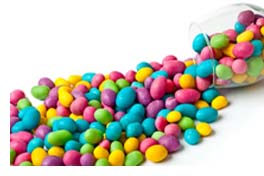
Blue Candy without Chemical Colorants
Now, there is the prospect that children can eat blue candy without the risk of developing allergies. Blue-green algae will push synthetic blue colour out of candy, cookies and soda.
Blue candy, cakes and fizzy drinks are loaded with synthetic colorants. It is not possible today to find a decent natural alternative to blue colorants in foods. But the synthetic colorant has some unfortunate side effects.
-The blue synthetic colorants are suspected to cause allergies and ADHD. Therefore, there is a great desire to find a natural alternative that is stable, explains Professor Lars Porskjær Christensen, Institute of Chemical Engineering, Biotechnology and Environmental Technology at the University of Southern Denmark.
Blue-green algae in sweets
The Danish Advanced Technology Foundation has just given the University of Southern Denmark 3,8 million kroner to conduct research on how to replace the synthetic blue colour in foods with the blue colour from blue-green algae. Lars Porskjær Christensen expects that the food industry will soon be able to put the synthetic colours on the shelf.
- The goal is that we can completely avoid synthetic food colours. Simultaneously, we want to create an effective product that can ensure the competitive advantages of the food industry, he says.
Must have the correct blue colour
Today, you can buy buckets of natural colorants extracted from blue-green algae, but the challenge will be to make colorants suitable for colouring foods. Before the natural colour can become successful, it requires, among other things, that the colour can be stabilised so that the blue owls can get the specific blue colour, which is the signature of the sweet.
Project Participants
Besides the University of Southern Denmark, the Danish Technological Institute, R2 Group, Heede Bolcher and Bæchs Conditori participate in the project. The total investment of the parties is 11,3 million kroner.
- Through SDU RIO – TEK Innovation we have developed the idea and devised an application which the Danish Advanced Technology Foundation wished to support, says Lars Porskjær Christensen.
For additional information contact
Head of Department, Professor Lars Porskjær Christensen, Institute of Chemical Engineering, Biotechnology and Environmental Technology at the University of Southern Denmark.
Mobile: 2778 7494
Email: lpc@kbm.sdu.dk